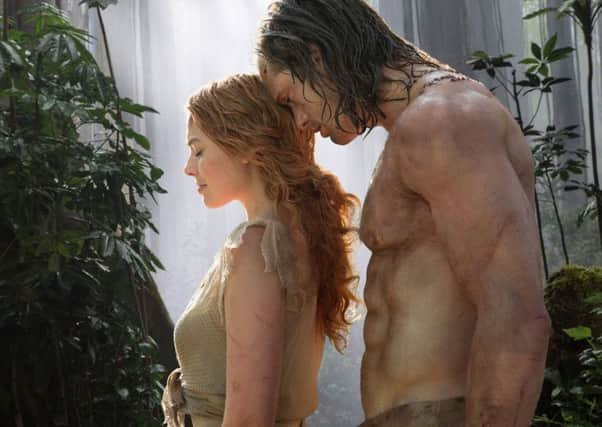Margot Robbie on portraying a very 21st cebtury Jane in the new Tarzan movie


Eight years is a lifetime in the movies. Stars come and go. Careers wax and wane. Tastes change and audiences’ fickle natures determine the future success of those people that make a living from the business known as show.
Eight years ago Margot Robbie was 19 and living in Australia. Bitten by the acting bug, she took lessons and broke into movies with roles in two low-budget dramas, Vigilante and I.C.U., both directed by Aash Aaron.
Advertisement
Hide AdAdvertisement
Hide AdThen came Neighbours, 200-plus episodes between 2008 and 2011, followed by the ABC series Pan Am, playing a glamorous airhostess. In anyone’s book, that’s an impressive (and industrious) run of work in four short years.
No one could have predicted what Robbie would do next. She set her sights on movies, left Australia and became that rare creature, a breakthrough star about which people only wrote good things.
The film was The Wolf of Wall Street. The co-star was Leonardo DiCaprio. The director was Martin Scorsese. The role, oozing sex appeal and animal cunning, was Naomi Lapaglia. And Robbie, at the age of 22, almost stole the film.
She’s been canny with her choices. She played support to Michelle Williams in Suite Française, partnered Will Smith in the so-so Focus, and will soon be seen in the ensemble of Suicide Squad, with Smith again. But the film that completes her transformation to leading lady is The Legend of Tarzan. In the tradition of “Me Tarzan, you Jane” she plays Lady Jane Clayton in a tale that looks beyond the origins of Edgar Rice Burroughs’ character.
Advertisement
Hide AdAdvertisement
Hide Ad“It’s funny…” says Robbie, “I never really thought of Jane as being a heroine. I wanted her to be real and be good and be happy and be sad… just [to] be real in that sense. There’s no fun in playing a two-dimensional character.
“Jane is quite independent. She’s not quite so reliant on Tarzan – I kinda like the stronger female, [and] she’s definitely a strong character.”
In the pantheon of the various incarnations of Jane, Robbie’s interpretation is wholly modern and fiercely emancipated. This is not the damsel in distress as portrayed by Maureen O’Sullivan or Brenda Joyce in films of yore. Neither is she the clothes-shedding body beautiful as represented by Bo Derek, or the buttoned-up Victorian city girl thrust into the wilds as played by Andie MacDowell.
The Victorian backdrop is still very much evident but it’s Jane who pushes for a return to the jungle, not her reluctant husband played by Alexander Skarsgård.
Advertisement
Hide AdAdvertisement
Hide AdSays Robbie: “It’s a slightly different take on the traditional Tarzan story. It takes place later on, so it’s not about finding Tarzan in the jungle. It’s a great action-adventure/love story. And it’s traumatic.”
Skarsgård follows in the loincloths of everyone from Johnny Weissmuller – we hear the traditional cry as a nod to the classic black-and-whites of the Thirties – to Ron Ely to Miles O’Keefe and Christopher Lambert.
But even he acknowledges that this incarnation of Tarzan/Lord Greystoke has taken on a darker hue. As Robbie says, “They both know that they need to go home and that London is not their home. They’re forcing it on themselves, ultimately. [The jungle] is definitely home for Jane and deep down it’s Tarzan’s home, too.”
Skarsgård offers his take on the Tarzan/Jane pairing. “You find them probably not where you expect to: they’ve been in London for nearly a decade. He’s not Tarzan anymore. He’s Lord Greystoke, John Clayton III. And he’s acclimated to life in London.
Advertisement
Hide AdAdvertisement
Hide Ad“He has everything. He’s married to Jane, they live in this beautiful mansion but his heart is still in the jungle. He doesn’t fit in. The jungle is his home but it’s not a fairy-tale. It’s a dark past.
“A lot of bad things happened there – a lot of things that he was involved in. He has some very powerful enemies back there so it’s a tough decision to go back.” Robbie adds: “The theme of home and finding your home and where you belong is relevant in all the other Tarzan stories because he’s growing up with the apes.” This one, she argues, is markedly different: he’s going home as a government emissary, uncertain of what he will find there.
There’s a superhero element to Skarsgård’s aristocratic ape-man that perfectly balances the creepy, businesslike villainy of Christophe Waltz, who is forever gazing at Robbie with malevolent appeal.
And if the story has been given a twist to win over 21st century audiences then Robbie accepts that the combination of Victoriana, CGI, jungle terrors and a hero who regresses into a raging beast to win the day is what makes this movie accessible.
Advertisement
Hide AdAdvertisement
Hide Ad“I’ve never been part of a film of this scale before,” she confesses. “I read the script and everything felt so big and epic. It had the romance, intelligent dialogue, cool fight scenes and it ticked all the boxes. I thought it would be a lot of fun to be a part of.
“There hasn’t been a live-action version of Tarzan for a couple of decades and you can expect a really immersive, visceral experience and we have the technology to do that these days.”
And her thoughts on Tarzan co-star Skarsgård, who stands tall at 5ft 4-and-a-half inches? Robbie, not exactly petite at 5ft 6ins, giggles.
“Alexander is really big! I look like a hobbit next to him! We were doing camera tests and my fingertips were literally at his kneecaps. I think every girl on set was swooning over him.”
The Legend of Tarzan (12A) is on saturation release.